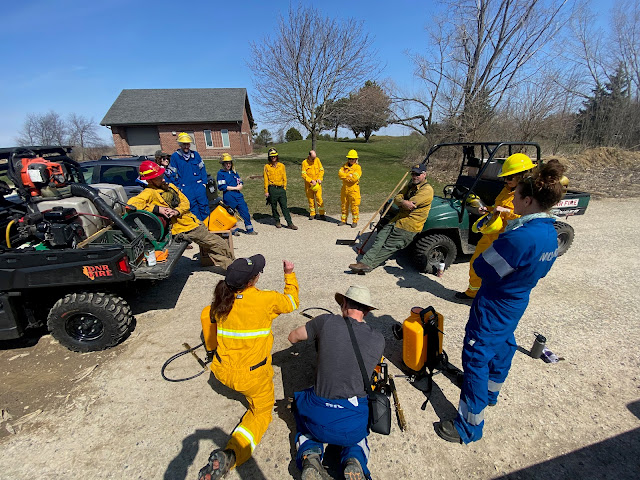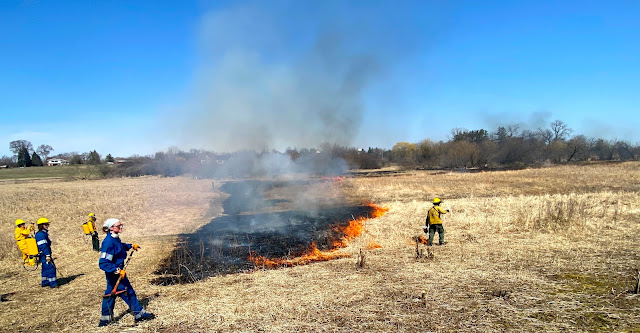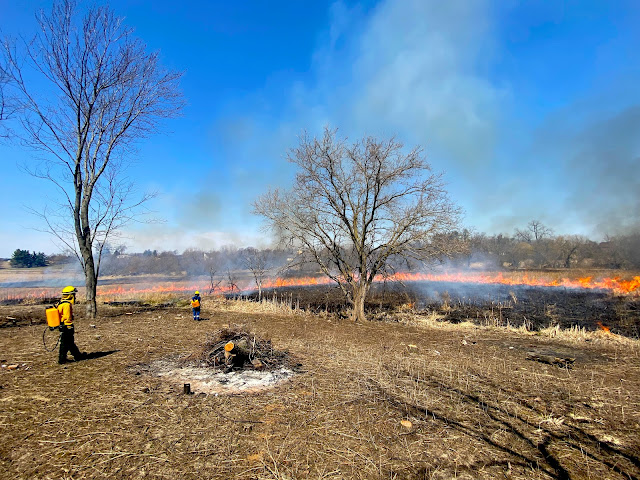This is a shortened, step by step, story.
For a lot more detail, see the Strategies for Stewards post.
The plan was prepared by Illinois Nature Preserves staff John Nelson. As shown on John's map (below), with a wind from the southwest, we would start at A and carefully complete a backfire to B.
Before we start, the area looks like the above. A-B is in the foreground: a degraded, early-stage prairie restoration with not much fuel. In the background are the fens and sedge meadows, with lots of fuel.
And now, we've reached point D on the plan. For a refresher, see below.
Once we've finished this break down to the golf course, we're done with the hard work.Now the work is done, and the headfire is lit.
The drone video below by David Martin gives a "hawk's eye view." Note how much bigger the headfire can be, compared to the backfire.
At this point we noticed that one of the raised fens had entirely escaped the burn. The sedge meadow that surrounded it was wet and had little fuel, as last year we had sprayed out the invasive Reed Canary Grass that had been thick there. But it was the fens that were the priority to enrich by burning, so Ben Davies hiked back down with the drip torch and touched it off.
At the end, we gathered for an "after action review." We discuss options, ask questions, explore suggestions, and definitely committed to deal with those nasty invading brush that had given us a hard time along the stream. We need more trained burn leaders and crew, so education and experience are another high priority. Public relations is also important. The golf course was busy, and one of Amy's jobs was to talk with golfers as they came by and answer questions.
Honor Roll
People deserving recognition:
For preparations: Rebeccah Hartz, Eriko Kojima, Amy Doll, and John Nelson
Burn boss for the day: John Nelson
Crew: John Nelson (INPC), Patti West (Kish volunteer), Ben Davies (Boone County Conservation District and Kish volunteer), Kent Beernink (Kish Volunteer), Sadie Dainko (Kane County Forest Preserves and Kish volunteer), Rebeccah Hartz (Shaw and Somme Woods volunteer), Amy Doll (Friends of Illinois Nature Preserves director and Kish volunteer), Dave Griffith (ILDNR), Ellie Krall (Shaw volunteer), Athena Knisley (Plank Road Prairie volunteer), Justin Hunger (Plank Road Prairie volunteer), and drone videographer David Martin (friend of Amy).
After the burn, we did a bit more planning for what comes next.
Life is good.
Acknowledgements
Thanks to Amy Doll and Eriko Kojima for edits and proofing.
Thanks to David Martin for the drone video.























No comments:
Post a Comment